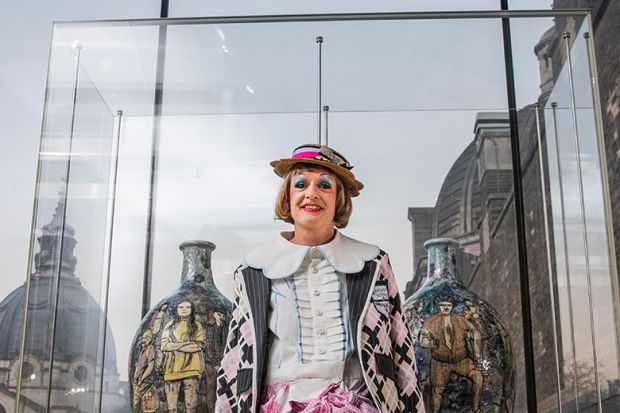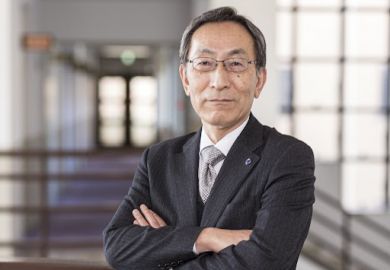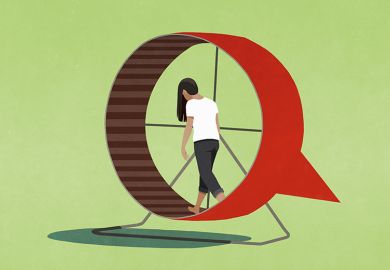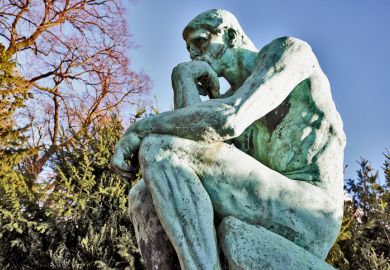Few living British artists hold the status of “national treasure” as securely as Grayson Perry does.
Already well known within the contemporary arts scene, he gained much greater public recognition in 2003 when he became the first (and so far the only) self-proclaimed “transvestite potter” to win the Turner Prize, the prestigious annual award for British visual artists. And despite (or perhaps because of) the potential discomfort caused to some by the sight of a made-up man in outlandishly colourful frocks, Perry went on to become a household name.
He delivered the BBC Reith Lectures in 2013 and has written and presented many television programmes – exploring issues such as Brexit, class, masculinity and rites of passage – which are notable for their compassion and their attempt to heal social divisions. His exhibitions, including the recent Super Rich Interior Decoration at London’s Victoria Miro Gallery, may nibble at the hand that feeds him by satirising the people who buy his work, but seem unlikely to give major offence.
Yet it was not ever thus. Perry – who was appointed chancellor of the University of the Arts London in 2015 – was clearly once a very confused and angry young man, who happily embraced provocative and even shocking material. There are several examples in the 2007 book he wrote with Wendy Jones, Grayson Perry: Portrait of the Artist as a Young Girl. One vignette concerns his 1982 degree show at what was then Portsmouth Polytechnic, where he produced a piece called The Death of Macho, a bronze “figure of a classical god with a great big hard-on being crucified on a Harley-Davidson”. This emerged from the mould and needed smoothing off just as the then arts minister, Paul Channon, happened to be visiting the studio. Since students had been “instructed to look very industrious”, Perry “tore off a strip of emery paper and started polishing the knob furiously, shh-shsh, shh-shsh, shh-shsh, so when [the minister] came and looked over my shoulder I was wanking off this little sculpture as fast as I could with sparks flying”.
More disturbing were Perry’s early efforts in the ceramics medium he has now made his own. Because he consciously “wanted to offend”, he recalled in 2007, he made use of “the rudest images I could think of: women being shagged by wolves, handicapped Fascists, Thalidomide girls, lots of swastikas, S&M hospitals, all the stuff that was free-flowing very crudely out of my mind…Apparently some students led a delegation to the head of the college to complain about me.”
In terms of his own life and career, Perry is very clear about how he got from where he started to where he is now.
“What happened in between”, he says, “is meeting my wife and having therapy, a long process of self-awareness and understanding my own unconscious world, which still surprises me to this day…Therapy is a way of cleaning out the tool shed – you clear out the rubbish and keep the tools and they are easier to find on a nice rack.”
Much of Perry’s early work has now been brought together for an exhibition titled Grayson Perry: The Pre-Therapy Years, which opens at the Holburne Museum in Bath on 24 January. In the accompanying book of the same name, co-editor Catrin Jones argues that “the raw explosiveness of the early works presents an unedited Grayson Perry”. Yet, she adds, these pieces also pose a troubling question: "do we accept the undeniably brutal sexuality, misogyny and racist symbolism as part of Perry’s personal journey to a more enlightened place?"
The specific case also raises some more general issues about arts education. How far do colleges need to allow young artists to explore the darkest sides of themselves, however offensive to others, as a way of working through them and perhaps moving on to less confrontational subject matter? Do they need to license certain forms of “bad behaviour” that might be frowned upon elsewhere in universities? And what advice does Perry have about how aspiring artists should be taught?
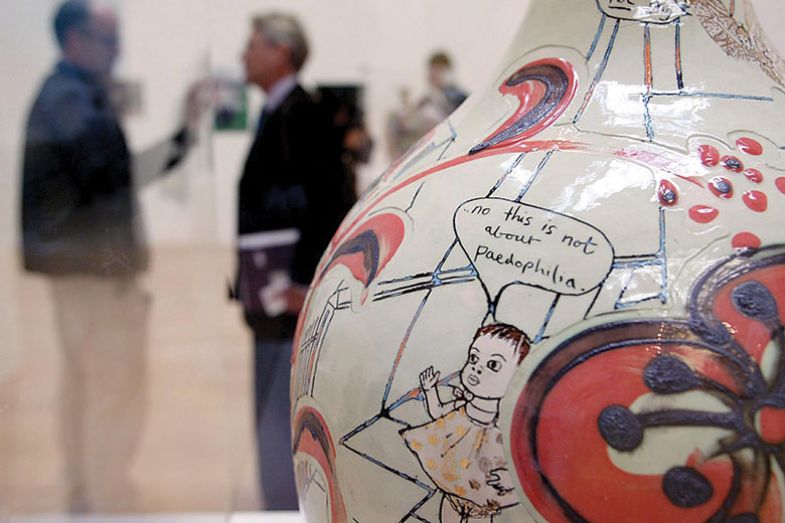
Part of the fun of his early work, Perry tells Times Higher Education at his north London studio, is that the medium of ceramics is usually seen as “very polite”; it would have been “a bit odd if the vice squad had come and arrested me for a load of ceramics”, he laughs.
Dressed in casual working gear but with nails painted in a bright red that he describes as “glacé cherries”, Perry goes on to recount – with some relish – that “one of my early collectors was Jewish and bought a piece with a great big swastika on it and said: ‘My mother’s going to hate this, but I really love it.’” Yet he acknowledges that “a student would get into trouble now for doing some of the things I did”.
On the vexed issue of whether students and artists should be allowed to depict others in stereotypical ways, Perry offers the startling view that “transvestites are the most sexist people on the planet because we depend on gender stereotypes. We get off on wearing the ‘wrong’ clothes. If there was no ‘wrong’ and everybody was gender-fluid, transvestites wouldn’t exist.” And he has little time for a climate in which “it’s almost a hobby to be offended. It’s like birdwatchers. I’ve been offended by X – tick! Are you [really] offended or do you know that you are meant to be offended by that?…It’s a consequence of the social media world: everybody has a very clear idea of where they think the boundary is. If you cross it by one toenail, you are cancelled.”
Asked explicitly whether art students should be free to address the violent and arguably offensive themes he once explored, Perry responds: “Totally! You’ve got to vent!” However, he also adds the more cautious caveat that students "need to have some awareness of where that language is going. To some extent, I was just venting. I didn’t think too hard about how people would take it.”
But while the modern era is more politically correct than previous decades, there are other senses in which it is much less strait-laced. When Perry was studying at Portsmouth, the hundred or so students doing fine arts were “very much part of the institution but also separate, in a bloc amid a load of geographers and economists and whatever. It made us into a very tight-knit and beleaguered little tribe of bohemians…We were artists and did daft things.” But “what would have been considered on-the-edge bohemian behaviour 50 years ago is a regular Saturday night out for someone who works in B&Q” now.
In that context, Perry sees no need for art colleges to be “the chemistry lab of outrageous social behaviour they might have been in the 1960s”. And he certainly feels “no nostalgia for abusive behaviour” or for the old-time lecturers “who had two pints [for lunch] and would then go and shag a student in the afternoon”. Yet he also fondly remembers his own affair with a lecturer, which “went on for quite a long time and continued after college. Because she was a woman, it had a different tone. She instigated it – though I’m sure she wouldn’t have crossed that line now…[The real issue is] the abuse of power. If it’s a [consensual relationship] among equally powerful people, then I think that’s OK.”
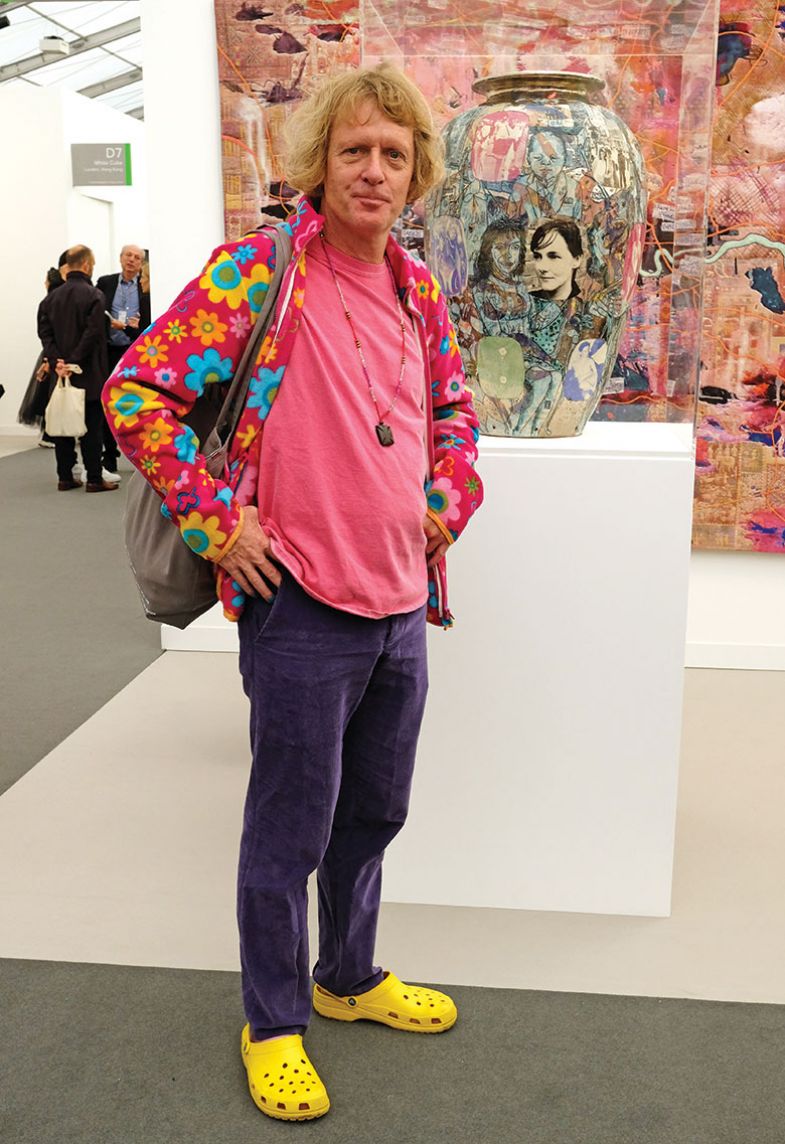
At present, Perry’s most hands-on involvement with arts education is a six-week course for fashion students at London’s Central Saint Martins, where he has been teaching for the past 15 years. “I brief them and they design, print and make me dresses, which I buy if I like them,” he explains. “I usually buy between half and two-thirds of them.” This typically amounts to between 20 and 25 every year, but on the day that the Brexit referendum result was announced in 2016, “I felt sorry for them and bought them all!”
Central Saint Martins is one of six colleges making up the University of the Arts London, where Perry still serves as chancellor. He was reappointed to the position in 2018, for another three years, despite his confession that staying on message is not his forte.
“I always describe the chancellor’s role as the dirty teddy bear tied to the front of the dustcart, to attract the children,” he explains. “I am a liability, I sometimes think. One misstep, which is so easy to make these days, and I think I’m going to be cancelled.”
It seems unlikely, for example, that the university will take on board Perry’s suggestion that art schools should be much more minimalistic institutions: “more like bases you touch rather than establishments…Maybe there’s a model where you have a kind of warehouse and there’s less emphasis on equipment and staff.”
Yet Perry was appointed chancellor at UAL in spite of the acceptance speech he gave there in 2009 when he was given an honorary doctorate, during which he remembers arguing that "the one thing you should be teaching at art college is less people…It’s a really tough career because of the economic landscape. You’re never going to be able to afford a studio in London. Your chances of making that leap from the communal exhibition held out in a warehouse God knows where to a commercial gallery are now much less, because there are so few steps in between.”
Even if art colleges don’t want to cut down on the number of students they admit, however, Perry believes they should provide them with more reality checks. This outlook reflects his view that although artists “can get a bit uppity thinking there’s a sort of specialness about them”, they are in many ways “just regular professionals”. And he is the first to admit that he has benefited from his USP as “the transvestite potter: having a strong brand is crucial in any creative field when you’ve got such a crowded market…Now galleries have a team of PRs. Any artist worth their salt is going to have to think about how they appear in the world if they are going to cut through the fantastic noise, especially online.”
Arts students benefit greatly from “some prolonged and realistic experience of the world they are going into. If you’re an artist working in a shed in Shropshire and complain that no one comes to see your work, I want to go: ‘You’ve never been to art college. You’ve never hung out at a private view. You’ve never talked to anyone in power in the art world. How can you expect to have a conversation with them?’”
As for what arts schools should do less of, Perry is suspicious of the move to introduce more academic models into the teaching of the arts. Describing himself as “an artist who operates in a sensual and emotional as well as an intellectual realm”, he expresses concerns about the way that today’s higher education, even in the arts, “puts great store on the intellect, really overprivileges it, whereas we’ve got to start rebalancing our attitudes to value – particularly in a very classed society – and to the body and emotion”.
The stakes here, Perry adds, are very high. If higher education institutions don’t get the balance between theory and practice right, “we are all going to get bitten on the bum like we have been by recent elections, where we are seeing the results of resentment against the overeducated”.
Grayson Perry: The Pre-Therapy Years is at the Holburne Museum in Bath from 24 January until 25 May, before moving on to the York City Art Gallery (12 June-20 September) and the Sainsbury Centre for Visual Arts, Norwich (18 October-31 January 2021). The accompanying book of the same name, edited by Catrin Jones and Chris Stephens, is published by Thames & Hudson on 24 January.
后记
Print headline: Grayson Perry: potter and provocateur
